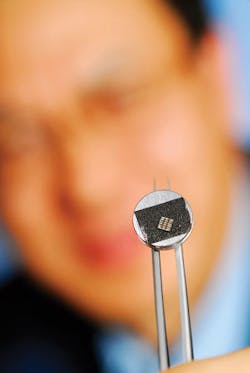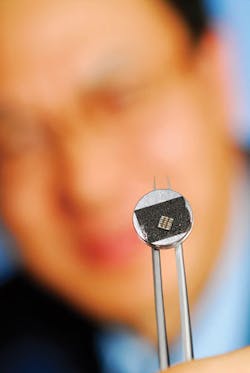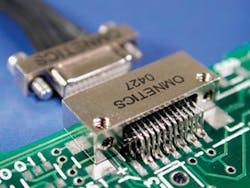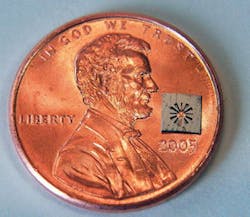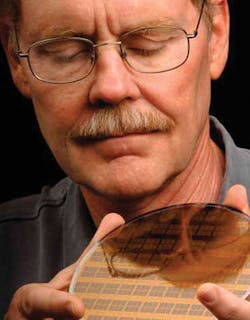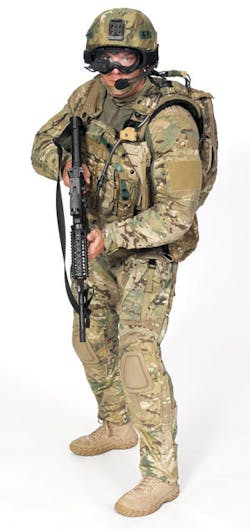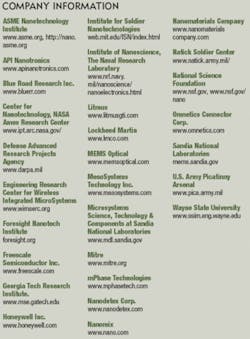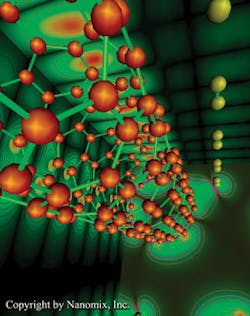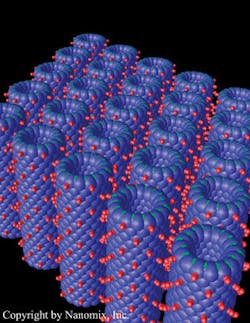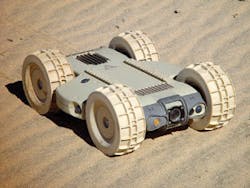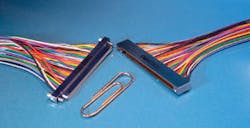Science of the small
Miniature MEMS and nanotechnology devices solve challenges in defense, security, and aerospace applications.
By Courtney E. Howard
Miniaturization technologies, such as microelectromechanical systems (MEMS) and nanotechnology, permeate our existence. “Nanoparticles are present in many things that one comes across in daily life,” says Dr. Ramanathan Nagarajan, research chemical engineer at the U.S. Army Natick Soldier Research, Development, and Engineering Center (NSRDEC), Macromolecular Science Team, in Natick, Mass. “Cosmetics, pharmaceuticals, and food packaging all have nano elements.”
“The modern inkjet printer’s print head is really a sophisticated MEMS device,” explains Dr. Martin Moskovits, chief technology officer at API Nanotronics Corp. in Toronto. Moreover, today’s cellular phones and digital cameras use “micro” and “mini” memory cards, which are essentially a small printed-circuit board with a tiny chip and nanoconnector. It is little wonder, then, that MEMS and nanotechnology are making waves in popular culture.
mPhase Technologies of Little Falls, N.J., posted a video demonstration of its smart battery based on nanotechnology-and, later, one based on its ultrasensitive sensor magnetometer-on YouTube (www.youtube.com), the popular video-sharing Web site. The smart-nanobattery production ranked among YouTube’s top-rated, most viewed, most discussed, and favorite videos.
Similarly, conferences and exhibitions centered on nanotechnology and MEMS abound today, with myriad events by industry organizations (NSTI’s Nanotech, www.nsti.org), media resources (NanoCon International from Small Times magazine, www.smalltimesnanocon.com), and many other industry players. This spring, in fact, Lockheed Martin hosted a small-business nanotechnology day to foster industry collaboration and partnerships. Twenty-two nanotechnology enterprises were in attendance, many of which are working on R&D programs funded by Department of Defense Small Business Innovation Research (SBIR) grants.
“There is tremendous potential in nanotechnology and related disciplines to have a very positive impact on our future,” says Dr. Les Kramer, director and chief technologist at Lockheed Martin Missiles and Fire Control in Dallas. “For example, weapons will become smaller, lighter, and smarter. Electronics will shrink in size, but have greater capabilities and memory. Sensors will see farther, with greater resolution.”
Tangible benefits
MEMS and nanotechnology-no longer the stuff of dreams confined within the walls of research laboratories-have bred products useful in today’s military and aerospace environments. MEMS- and nanotechnology-based devices and materials provide benefits that include reduced size, weight, and power, and cost (SWaP-C).
“Nanotechnology is rapidly moving out of the lab and into mainstream industrial and commercial applications,” says Matthew Laudon, executive director of the Nano Science and Technology Institute (NSTI) in Cambridge, Mass.
MEMS technologies have contributed to the production of micromachines, micro-integrated circuits, and micro-optics used in the defense, security, and aerospace sectors. LADAR/LIDAR, infrared cameras, miniature unmanned vehicles, target-recognition devices, head-mounted displays, robotic-guidance systems, night-vision goggles, reconnaissance systems, thermal imagers, and friend/foe identification solutions benefit from MEMS.
Nanotechnology benefits the design and development of miniature chemical and biological sensors, flexible and wearable displays, portable x-ray devices for medical use and cargo inspection, and RF amplifiers for radar, communications, and electronic countermeasures.
NASA engineers are eliciting the help of MEMS and nanotechnology in the creation of smart sensors and probes, overall system miniaturization, autonomous spacecraft, microspacecraft, micro- or nano-rovers for planetary exploration, and compact, low-power, high-performance computing platforms.
MEMS in space
While Dr. Keith Ortiz, manager of the MEMS Technologies Department at Sandia National Laboratories in Albuquerque, N.M., could not discuss current defense projects due to the nature of Sandia’s work, he did reveal information about Sandia’s delivery of MEMS-based microshutters to the Johns Hopkins University Applied Physics Laboratory for NASA’s Space Technology 5 (ST5) mission-the first MEMS to fly in space.
NASA engineers working on the ST5 satellites were concerned about severe temperature fluctuations affecting the performance and longevity of the onboard electronics. Sandia MEMS designers worked with researchers at Johns Hopkins University’s Applied Physics Lab in Baltimore to help develop a MEMS-based microsatellite thermal-control solution. In addition to using Sandia’s SUMMiT V technology, the device incorporates a moving grillwork of shutters with slats that measure 6 microns wide and 1800 microns long. (A human hair is roughly 100 microns thick.) Electrostatic actuators move the shutters back and forth to manage heat transfer through the satellite’s skin.
“This is the first time a space-qualified device of this type has ever been flown [in space], and the first to be flown on the outside of a satellite,” says Ann Darrin, program manager at Johns Hopkins Applied Physics Lab.
The NASA ST5’s three orbiting microsatellites, which have completed their three-month mission, incorporate a wealth of MEMS technologies and nanoscience. Each fueled satellite, roughly the size of a 13-inch television, weighed approximately 55 pounds when launched, employed a single microthruster the size of a quarter, measured the magnetic field using miniature magnetometer, and used miniature spacecraft radio transponders for space-to-ground communications and tracking.
The project, developed and tested at Goddard Space Flight Center in Greenbelt, Md., is part of the New Millennium Program, managed for NASA by the agency’s Jet Propulsion Laboratory, Pasadena, Calif. The program involves the development and testing of technologies that provide future science mission capabilities with a high payoff and reduced cost and risk.
“I’m kind of in awe that these MEMS devices are in space,” says Sandia researcher Jim Allen. “It’s a cool milestone for MEMS devices.”
“We are only beginning to realize how these new developments may find practical applications,” Ortiz says. “The next wave of MEMS applications will be enabled by dense integration of MEMS devices. The micoshutters are a simple example of what is possible.”
Powerful stuff
Miniaturized systems require small and robust power supplies, yet packing sufficient fuel in a tiny form factor is not an easy feat. mPhase Technologies has developed-with help from a cooperative research and development agreement (CRADA) from the U.S. Army Armament Research, Development, and Engineering Center (ARDEC) at Picatinny Arsenal, N.J.-a miniscule battery.
Army researchers are evaluating the mPhase Smart Nano battery and ultrasensitive magnetometer prototypes using the Army’s testing facilities at Picatinny Arsenal to potentially incorporate the technologies into programs sponsored by Picatinny.
Potential defense applications for the mPhase magnetometer are perimeter security applications and navigation in “GPS denied” environments. The Smart Nanobattery could aid military efforts by powering small electronics, such as sensors, and small guided and smart munitions.
Initial tests indicate that the nanostructure of the prototype power cell and magnetometer demonstrated resiliency to shock and acceleration, surviving a test that subjected them to acceleration at a g-force of 12,000.
Accelerating MEMS
Another CRADA-this time between Omega Sensors Inc. and the Space and Naval Warfare Systems Center (SSC), Office of Research and Technology Applications, both in San Diego-is helping to advance MEMS technologies.
The Omega Sensors team is collaborating with scientists and engineers at SSC San Diego on the development of applications for the company’s MEMS ultra-sensitive accelerometer (MEMSUSA) technology.
MEMS accelerometers measure acceleration and movement in navigational vehicles, such as helicopters and airplanes, but are typically very expensive, priced in the range of tens of thousands of dollars.
Omega Sensor’s MEMSUSA accelerometer combines Fabry-Perot interferometer technology with MEMS technology. “The advantage of MEMS is a low-cost structure,” explains Brad Chisum, Omega Sensors president. “We’re able to the deliver high-cost performance, meaning up to $17,000, at the MEMS pricing level, which is less than $100, even at low production levels. This gives us a huge advantage.”
MEMS accelerometers could be used in guided missiles, unmanned ground, aerial, and underwater vehicles, and for monitoring the condition of helicopters and submarines by measuring their vibration. “If that vibration is beyond a certain threshold, then it is due for maintenance,” Chisum says.
Chisum has received funding to complete a third-generation prototype from the Center for Commercialization of Advanced Technology (CCAT) at San Diego State University. Omega Sensors received a $75,000 prototype development, test, and evaluation (PDT&E) award from CCAT San Diego, and additional funding from the Defense Advanced Research Projects Agency (DARPA) in Arlington, Va.
Due for release in the fall, the next-generation prototype will go beyond the MEMS accelerometer, adding navigational gyroscopes and multi-access accelerometers capable of measuring acceleration in multiple directions. “Navigation requires multiple accelerometers,” Chisum notes, “and integrating them on the same chip cuts the cost and size of the chip.”
The CCAT program seeks technologies engineered by government labs, academic researchers, and small entrepreneurs, and helps guide them through technology transfer process and into the hands of warfighters, first responders, and security personnel. The Omega Sensor accelerometer is expected to come to market within three years.
Powering nanodevices
As ingenious as today’s miniature devices are today, they still require bulky power supplies or fuel systems-negating some innovative work in various areas, such as unmanned vehicles. Yet work at Georgia Tech in Atlanta might be just the thing to free the nanomachine from the monkey (or batteries) on its back.
A team of researchers-including Xudong Wang, Jinhui Song, Jin Liu, and Zhong Lin Wang, a Regents professor in the Georgia Tech School of Materials Science and Engineering-has developed a nanogenerator that converts motion into electrical current. The nanogenerator is an array of tiny filaments-zinc oxide nanowires-that produces continuous direct-current electricity from mechanical energy. Safe enough for use in biomedical applications, the nanoscale generator could generate energy from internal vibrations and even blood flow.
“If you had a device like this in your shoes when you walked, you would be able to generate your own small current to power small electronics,” Wang notes. “Anything that makes the nanowires move within the generator can be used for generating power. Very little force is required to move them.”
The nanogenerator is expected to produce as much as four watts per cubic centimeter, sufficient power for nanometer-scale defense, environmental, and biomedical devices. Potential applications include powering nanomotors, biosensors implanted in the body, environmental monitors, and nanoscale robots.
The researchers developed the nanogenerator with the support of the National Science Foundation, DARPA, and the Emory-Georgia Tech Nanotechnology Center for Personalized and Predictive Oncology.
Infused with investments
Technology companies continue to make investments into the research, development, and production of MEMS and nanotechnology innovations. Product releases in the nanotechnology area, especially, are critical to the future of the science. It is often said that people don’t buy technology, they buy products; it keeps investor confidence high and holds the interest and funding of federal governments, where impatience can often kill a field of study. This is the challenge of today’s MEMS and nanotechnology firms, the managers of which are staying the course for the long term and continuing to invest in the technologies’ future.
“The investment in creating a MEMS capability is substantial,” Sandia’s Ortiz admits. “The potential payoff to national security is worth the investment. As it has in the past, Sandia will continue to work with industry and government to enable military and aerospace applications of MEMS.”
Also seeing promise in MEMS, executives at API Nanotronics Corp. in New York are opening a MEMS fabrication facility dedicated to the manufacture of sophisticated electronic components for the defense industry. “What we have heard from our military customers is, ‘We want to do this, we want to do that, we want to do it smaller,’ ” says Thomas Mills Sr., API Nanotronics president and chief operating officer.
Overseeing the project is the company’s newly appointed chief technology officer, Martin Moskovits, who played a role in establishing the five nanocenters of the U.S. Department of Energy as a member of its Basic Energy Sciences Advisory Committee.
“There’s a great deal of spending going on right now in R&D,” Moskovits adds. “For example, DARPA has a program called HERMIT (harsh-environment robust micromechanical technologies) that funds a great deal of research in MEMS technologies for the defense sector.”
Similarly, mPhase Technologies in Little Falls, N.J., formed AlwaysReady Inc., a wholly owned subsidiary dedicated to nanotechnology and MEMS-based products, and to transform homeland security and other markets. AlwaysReady currently offers two solutions for defense applications, such as detecting bombs or metal guns: a smart nanobattery capable of producing current on demand after long-term storage, and a family of uncooled magnetometers, including ultrasensitive versions.
“These products can save lives,” Ron Durando, president and CEO of mPhase Technologies, says. “In the coming years, the nanotechnology category will evolve into a trillion-dollar industry. The world has changed and we must change with it.”
Litmus to research carbon nanostructures for U.S. Naval Air Warfare Center
Litmus Defense LLC in Houston has entered into an agreement with the U.S. Naval Air Warfare Center Weapons Division (NAWCWD) at China Lake Naval Weapons Center, Calif., for the research and development of carbon nanostructures in advanced composite structures, such as rocket motors and warheads.
“There is significant potential for nanotechnology in defense applications and this collaboration provides a great opportunity for the development of our nanomaterials and applications,” Mark Diggs, CEO of Litmus, explains. “We have the resources, capabilities, and technical expertise to truly transform the results of this research effort for public use.”
The market for composite materials for use in aircraft and weapons systems is exponentially growing due to their inherent mechanical strength and durability, light weight, and conductivity, a company representative explains. The use of carbon nanotubes and nanofibers in rocket motor and warhead components and propellants, for example, promises increased thermal conductivity and performance, enhanced strength of materials and alloys, and reduced weight and size of structural components.
The NAWCWD investigates advanced technologies related to tactical naval air weapons systems. More information about Litmus is available online at www.litmusgti.com.
Homeland Security invests in nanotechnology, awards Nanomix $1 million grant
The Department of Homeland Security (DHS) management has awarded Nanomix Inc. of Emeryville, Calif., a $1 million project grant.
The Nanomix grant will cover a three-year period, during which time Nanomix engineers will develop technologies in cooperation with the Naval Research Laboratories.
The grant supports the national effort to secure America by preventing and deterring terrorist attacks, and protecting against and responding to threats and hazards to the nation. Additional details about the project could not be disclosed for security reasons, explains a company representative.
Nanomix, the first company to bring a nanoelectronic detection device to market, offers a portfolio of devices based on its Sensation technology that enables the detection of a wide array of chemical and bio molecules. By design, the Nanomix Sensation devices combine ultrasensitive carbon nanotube detection elements with proprietary chemistries, consume little power, support wireless integration, and are small and easy to deploy.
More information about Nanomix is available online at www.nano.com.
Omnetics nanoconnectors for mil-aero applications are resistant to shock and vibration and provide lowest profile
Omnetics Connector Corp. in Minneapolis has unveiled the lowest profile metal-shelled connector available.
The release is a single-row version of the company’s nanominiature bi-lobe 0.025-inch pitch connector family, and boasts a profile of 0.115-inch high and Omnetics’s Flex Pin contact. Nanoconnectors are defined by Mil-Std-32139.
“The term bi-lobe has become synonymous with nanoconnectors,” Bob Stanton, Omnetics’s worldwide sales manager, says. “Bi-lobe connectors are preferred for their resistance to extreme conditions of shock and vibration, whilst in the miniature footprint. Applications include military, space, medical, and oil and gas equipment.”
In fact, the new offering has been proven to withstand a shock of 100G in each axis and vibration exposure from 10 to 2000 to 10Hz at 20G amplitude in each axis, in accordance with Mil-Std-32139.
Omnetics engineers design and customize military-quality, high-reliability micro- and nanominiature interconnect products, which feature commercial off-the-shelf and custom connectors, for military, aerospace, defense, and medical uses.
Applications for nanoconnectors are broad and varied. In the area of remote maneuverability and control, nanoconnector technologies are often used in the constrained compartments of missile-seeker heads.
“The highest use of nanoconnectors at Omnetics is for unmanned vehicle systems,” Stanton notes. “This industry is exploding in uses from military surveillance systems in the Predator to unmanned remote ground vehicles like the Army’s Dragon Runner.”
More information about Omnetics is available online at www.omnetics.com.
